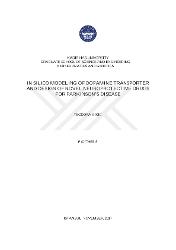| dc.contributor.advisor | Yelekçi, Kemal | |
| dc.contributor.author | Dikic, Teodora | |
| dc.date.accessioned | 2023-10-17T20:46:20Z | |
| dc.date.available | 2023-10-17T20:46:20Z | |
| dc.date.issued | 2017 | |
| dc.identifier.uri | https://tez.yok.gov.tr/UlusalTezMerkezi/TezGosterkey=vbVkXe1KChYWNElr1MuLZggB2SkmRSLlnpk1v93iJTuHvZl9nwhG-LxfaIuml1Yv | |
| dc.identifier.uri | https://hdl.handle.net/20.500.12469/4480 | |
| dc.description.abstract | Parkinson hastalıgı (PH), substantia nigra (SN) ve corpus striatum (CS) bolgelerinde dopamin ureten noronların kaybedilmesi ile karakterize edilen bir olgudur. Yaygın olarak uygulanan tedavi dopamin noronlarının kaybolmalarının korunması yonunde degilde ortaya cıkan semtopların azaltılmasına yoneliktir. Insan dopamin tranporteri (hDAT) yoluyla spesifik olarak sinir hucresine alınan ve dopaminerjik noronları hedefleyen secici sinir koruyucu (noron protektif) ilaclar gecerli bir strateji olabilir. Tedavide dopaminin hucre dısı biyoaktif mikatını artırabilen dolayısı ile dopaminerjik norotransmisyonun kaybını dengeleyen ve kuvvetlendiren ve sitoplazmada birikerek noroprotektif olarak davranabilen molekuller gerekir. Bu calısmada homoloji modelleme, molekuler doklama ve molekuler dinamik simulasyon metodları kullanılarak substrat ve inhibitorle komplekslenmis hDAT'ın uc boyutlu (3D) yapı modelleri bulunmustur. Gelecekte yapılacak ilac tasarımlarında onemli olan bilesiklerin farklı baglanma kinetiklerini acıklayabilen hDAT'ın acık ve kapalı konformasyonları olusturulmustur. In silico yaklasımla elde edilmis olan yapılar bilesik veri bankası taraması sonucunda bize umit vadeden uc substrat molekulunun tespit edilmesine olanak saglamıstır. Bu substratların in vitro canlı hucre goruntu deneyleriyle hDAT'a dayalı fluoresan substratın hucreye geri girisi (uptake) inhibe etme etkileri de analiz edilmistir. Butun bu sonuclar birlikte degerlendirildiginde calısmamız in silico/in vitro yaklasımılarını birlikte kullanılarak dopaminerjik notron spesifik substratlların seciminde bir ilk model olusturmaktadır. | en_US |
| dc.description.abstract | Parkinson's disease (PD) is characterized by the loss of dopamine-generating neurons in the substantia nigra (SN) and corpus striatum (CS). Current treatments alleviate PD symptoms rather than exerting neuroprotective effect on dopaminergic neurons. New drugs targeting the dopaminergic neurons by specific uptake through the human dopamine transporter (hDAT) could represent a viable strategy for establishing selective neuroprotection. Molecules able to increase the bioactive amount of extracellular dopamine (DA), thereby enhancing and compensating a loss of dopaminergic neurotransmission, and to exert neuroprotective response because of their accumulation in the cytoplasm, are required. By means of homology modeling, molecular docking and molecular dynamics simulations, we have generated 3D structure models of hDAT in complex with substrate and inhibitors. Our results clearly reveal differences in binding kinetics of these compounds to the hDAT in the open and closed conformations, critical for future drug design. The established in silico approach allowed the identification of three promising substrate compounds that were subsequently analyzed for their efficiency in inhibiting hDAT-dependent fluorescent substrate uptake, through in vitro live cell imaging experiments. Taken together, our work presents the first implementation of a combined in silico/in vitro-approach enabling the selection of promising dopaminergic neuron specific substrates. | en_US |
| dc.language.iso | eng | en_US |
| dc.publisher | Kadir Has Üniversitesi | en_US |
| dc.rights | info:eu-repo/semantics/openAccess | en_US |
| dc.subject | Nöroloji | en_US |
| dc.subject | Neurology | en_US |
| dc.title | In silico modeling of dopamine transporter and design of novel neuroprotective drugs for Parkinson's disease | en_US |
| dc.title.alternative | In sılıco olarak Parkınson hastalıgı ıcın yenı noroprotektıf ılac tasarımı ve dopamın transporterının modellenmesı | en_US |
| dc.type | doctoralThesis | en_US |
| dc.identifier.startpage | 1 | en_US |
| dc.identifier.endpage | 158 | en_US |
| dc.department | Enstitüler, Lisansüstü Eğitim Enstitüsü, Biyoinformatik ve Genetik Ana Bilim Dalı | en_US |
| dc.institutionauthor | Dikic, Teodora | |
| dc.relation.publicationcategory | Tez | en_US |
| dc.identifier.yoktezid | 498348 | en_US |
| dc.khas | 20231017-Tez | rn_US |
















